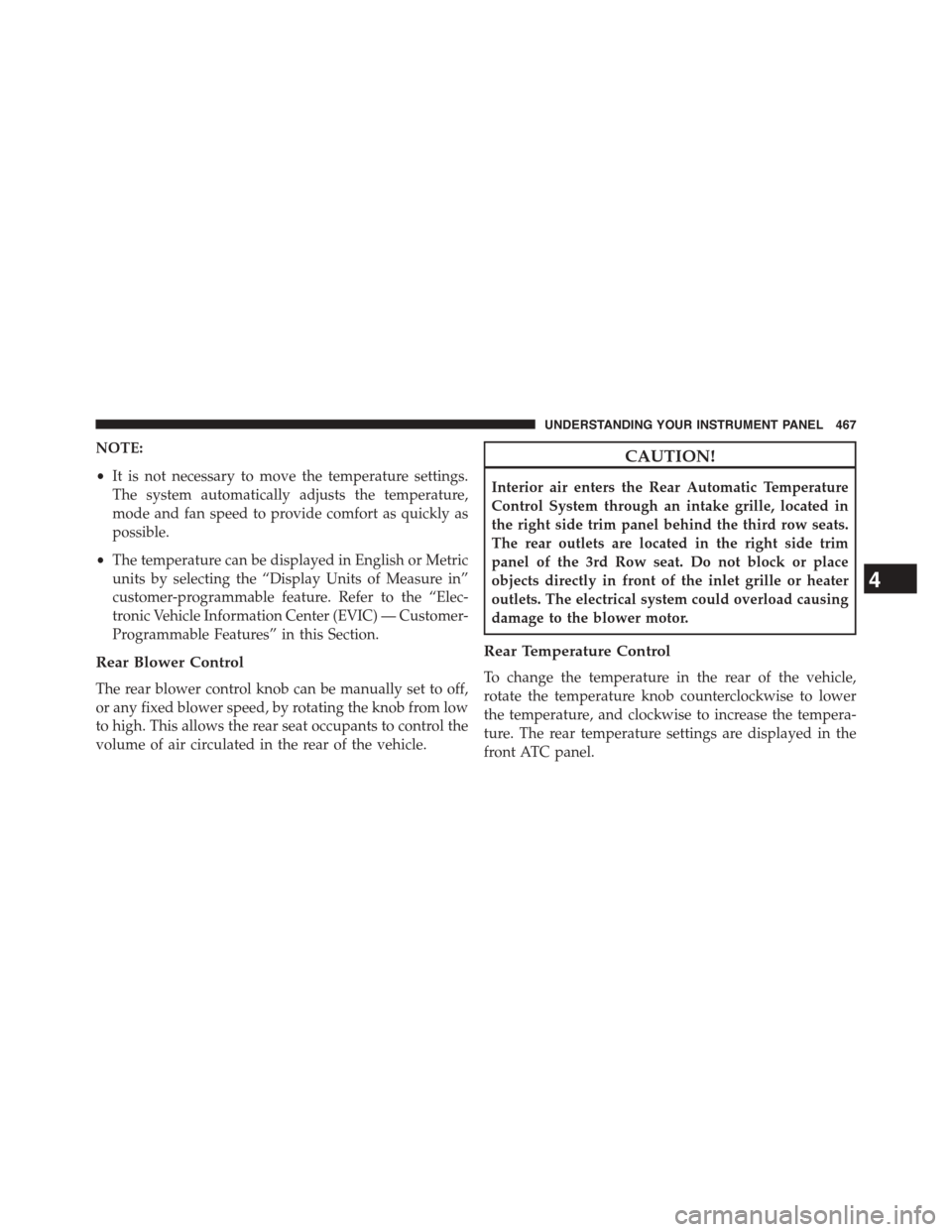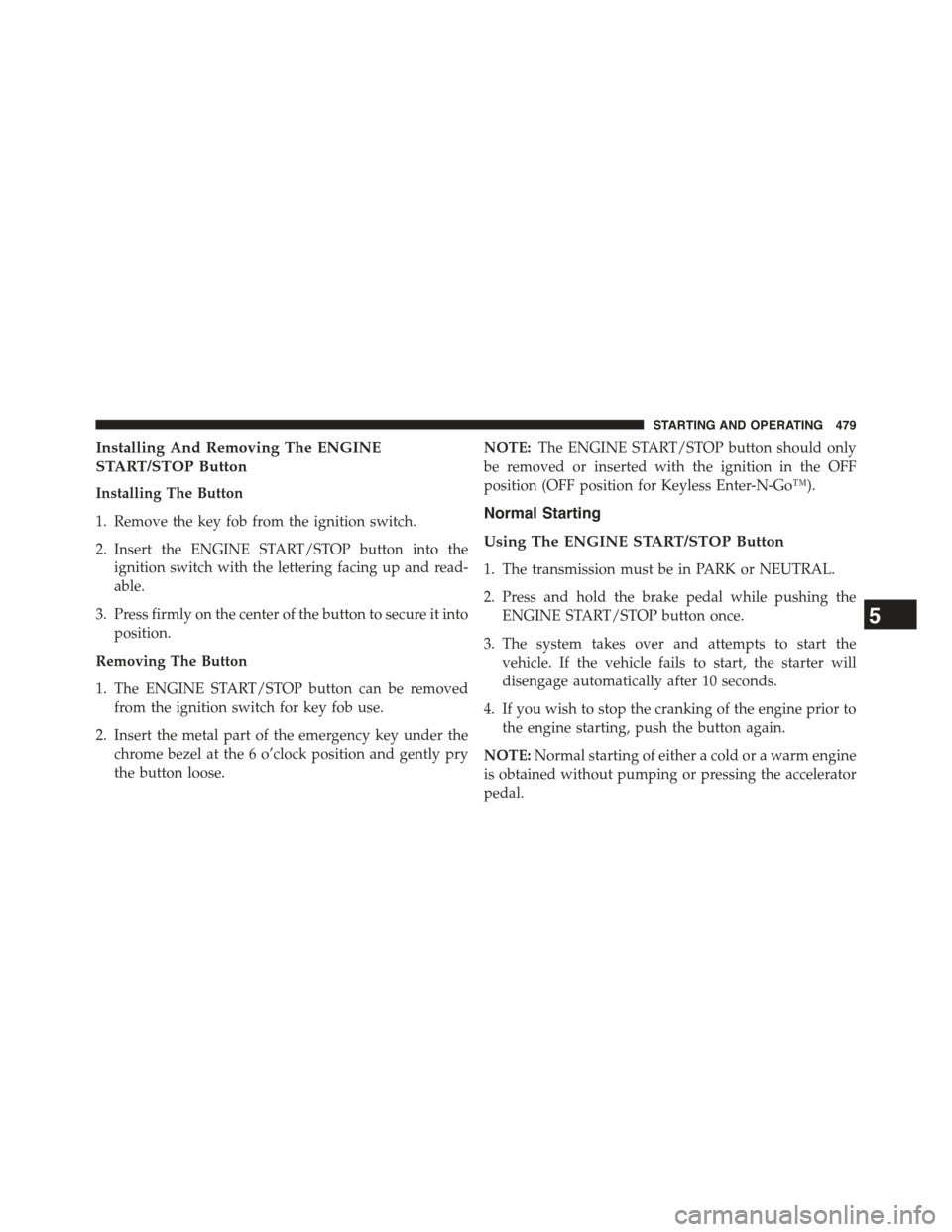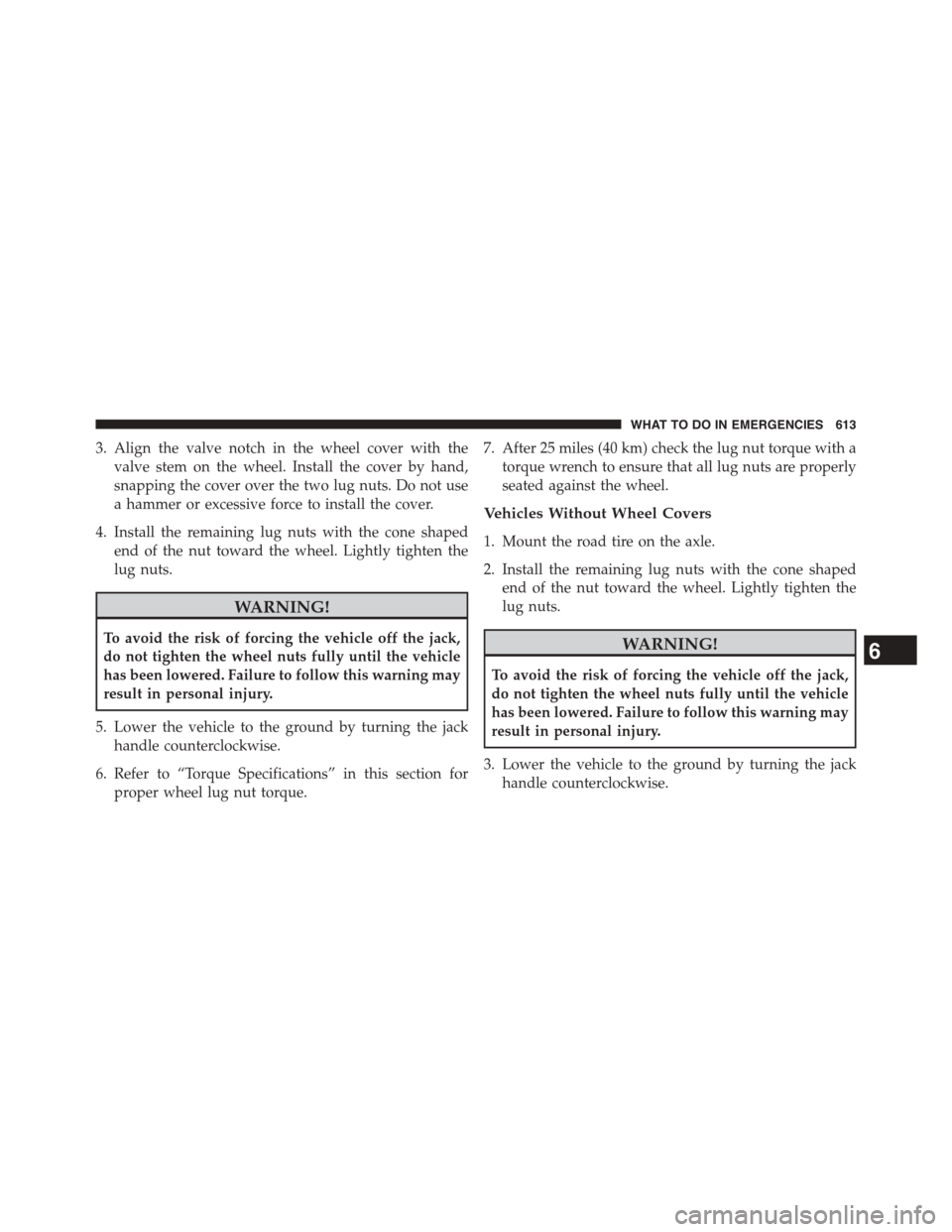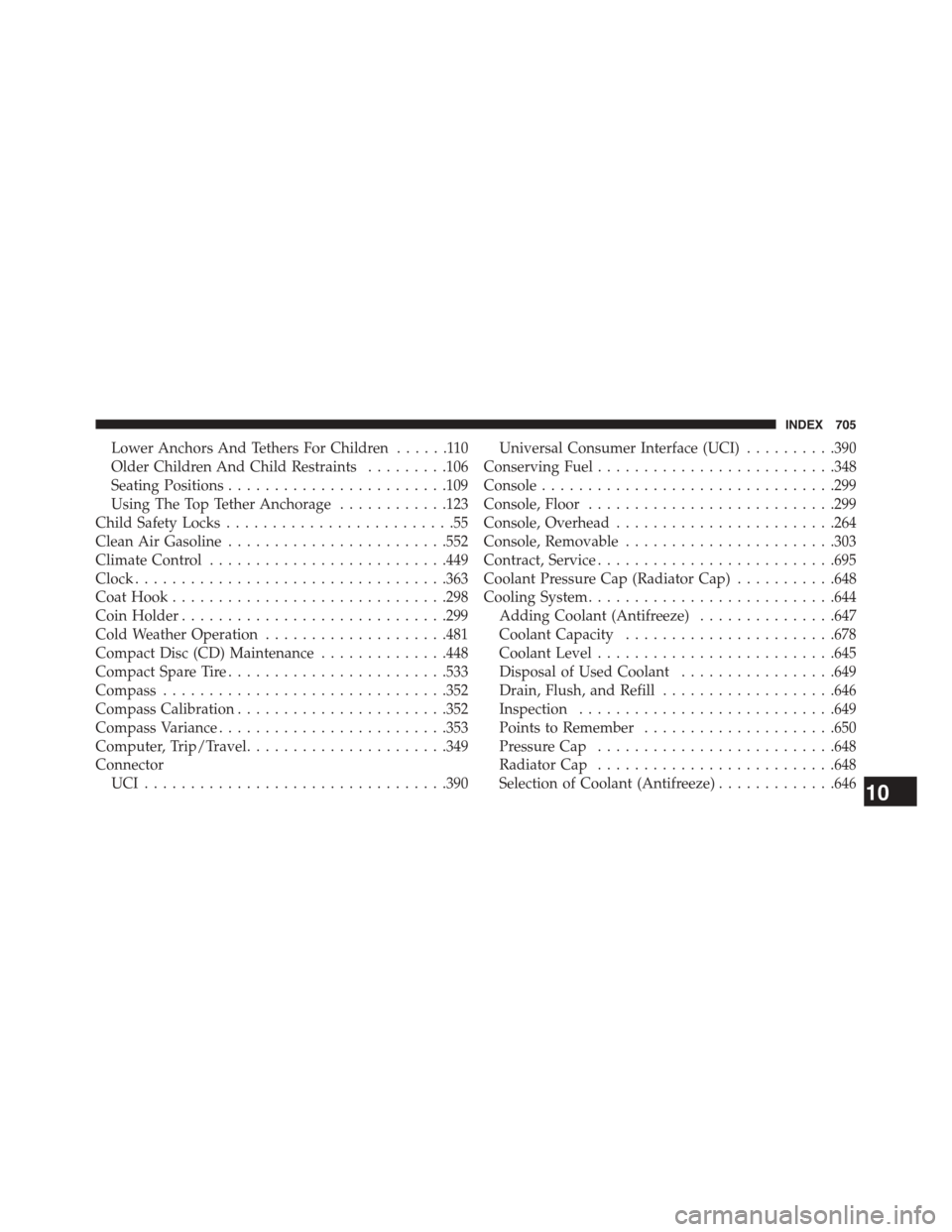Page 468 of 726
The rear ATC system is located in the headliner, near the
center of the vehicle.
1. Push the Rear Temperature Lock button on the front
ATC panel. This turns off the Rear Temperature Lock
icon in the rear temperature knob.
2. Rotate the Rear Blower, Rear Temperature and the
Rear Mode Control knobs to suit your comfort needs.
3. ATC is selected by adjusting the rear blower knob
counterclockwise to AUTO.
Once the desired temperature is displayed, the ATC
System will automatically achieve and maintain that
comfort level. When the system is set up for your comfort
level, it is not necessary to change the settings. You will
experience the greatest efficiency by simply allowing the
system to function automatically.Rear ATC Control Features
1—BlowerSpeed3—RearMode2—RearTemperature4—RearTemperatureLock
466 UNDERSTANDING YOUR INSTRUMENT PANEL
Page 469 of 726

NOTE:
•It is not necessary to move the temperature settings.
The system automatically adjusts the temperature,
mode and fan speed to provide comfort as quickly as
possible.
•The temperature can be displayed in English or Metric
units by selecting the “Display Units of Measure in”
customer-programmable feature. Refer to the “Elec-
tronic Vehicle Information Center (EVIC) — Customer-
Programmable Features” in this Section.
Rear Blower Control
The rear blower control knob can be manually set to off,
or any fixed blower speed, by rotating the knob from low
to high. This allows the rear seat occupants to control the
volume of air circulated in the rear of the vehicle.
CAUTION!
Interior air enters the Rear Automatic Temperature
Control System through an intake grille, located in
the right side trim panel behind the third row seats.
The rear outlets are located in the right side trim
panel of the 3rd Row seat. Do not block or place
objects directly in front of the inlet grille or heater
outlets. The electrical system could overload causing
damage to the blower motor.
Rear Temperature Control
To change the temperature in the rear of the vehicle,
rotate the temperature knob counterclockwise to lower
the temperature, and clockwise to increase the tempera-
ture. The rear temperature settings are displayed in the
front ATC panel.
4
UNDERSTANDING YOUR INSTRUMENT PANEL 467
Page 481 of 726

Installing And Removing The ENGINE
START/STOP Button
Installing The Button
1. Remove the key fob from the ignition switch.
2. Insert the ENGINE START/STOP button into the
ignition switch with the lettering facing up and read-
able.
3. Press firmly on the center of the button to secure it into
position.
Removing The Button
1. The ENGINE START/STOP button can be removed
from the ignition switch for key fob use.
2. Insert the metal part of the emergency key under the
chrome bezel at the 6 o’clock position and gently pry
the button loose.
NOTE:The ENGINE START/STOP button should only
be removed or inserted with the ignition in the OFF
position (OFF position for Keyless Enter-N-Go™).
Normal Starting
Using The ENGINE START/STOP Button
1. The transmission must be in PARK or NEUTRAL.
2. Press and hold the brake pedal while pushing the
ENGINE START/STOP button once.
3. The system takes over and attempts to start the
vehicle. If the vehicle fails to start, the starter will
disengage automatically after 10 seconds.
4. If you wish to stop the cranking of the engine prior to
the engine starting, push the button again.
NOTE:Normal starting of either a cold or a warm engine
is obtained without pumping or pressing the accelerator
pedal.
5
STARTING AND OPERATING 479
Page 615 of 726

3. Align the valve notch in the wheel cover with the
valve stem on the wheel. Install the cover by hand,
snapping the cover over the two lug nuts. Do not use
a hammer or excessive force to install the cover.
4. Install the remaining lug nuts with the cone shaped
end of the nut toward the wheel. Lightly tighten the
lug nuts.
WARNING!
To avoid the risk of forcing the vehicle off the jack,
do not tighten the wheel nuts fully until the vehicle
has been lowered. Failure to follow this warning may
result in personal injury.
5. Lower the vehicle to the ground by turning the jack
handle counterclockwise.
6. Refer to “Torque Specifications” in this section for
proper wheel lug nut torque.
7. After 25 miles (40 km) check the lug nut torque with a
torque wrench to ensure that all lug nuts are properly
seated against the wheel.
Vehicles Without Wheel Covers
1. Mount the road tire on the axle.
2. Install the remaining lug nuts with the cone shaped
end of the nut toward the wheel. Lightly tighten the
lug nuts.
WARNING!
To avoid the risk of forcing the vehicle off the jack,
do not tighten the wheel nuts fully until the vehicle
has been lowered. Failure to follow this warning may
result in personal injury.
3. Lower the vehicle to the ground by turning the jack
handle counterclockwise.
6
WHAT TO DO IN EMERGENCIES 613
Page 669 of 726
CavityCartridge Fuse Mini-FuseDescription
M11–10 Amp RedClimate Control System
M12–30 Amp GreenAmplifier/Radio
M13–20 Amp Yellow Instrument Cluster, SIREN, Clock Module,
Multi-Function Control Switch – If
Equipped
M14–20 Amp YellowTrailer Tow – If Equipped
M15–20 Amp Yellow Rear View Mirror, Instrument Cluster,
Multi-Function Control Switch, Tire Pres-
sure Monitor, Glow Plug Module – If
Equipped
M16–10 Amp Red Airbag Module/Occupant Classification
Module
M17–15 Amp Blue Left Tail/License/Park Lamp, Running
Lamps
M18–15 Amp BlueRight Tail/Park/Run Lamp
M19–25 Amp ClearPowertrain
7
MAINTAINING YOUR VEHICLE 667
Page 677 of 726
Front Side Marker Lamp
1. Raise the hood to access the rear of the headlamp
housing.
NOTE:Access is somewhat limited. You may have to
remove the inner fender well or remove the headlamp
housing for bulb replacement.
2. Twist the socket and remove from the headlamp
housing, then pull the bulb out.
3. Push the new bulb into the socket and reinstall the
socket by twisting until locked into the headlamp
housing.
Front Fog Lamp
NOTE:Access to the fog lamp bulb is from the rear of
the fascia. On the left rear side of the fascia, remove the
push pin and lower the hinged access door on the air
dam.
1. From behind the bumper fascia, or the access panel on
the air dam, twist the bulb counterclockwise, and
remove bulb.
CAUTION!
Do not touch the new bulb with your fingers. Oil
contamination will severely shorten bulb life. If the
bulb comes in contact with an oily surface, clean the
bulb with rubbing alcohol.
7
MAINTAINING YOUR VEHICLE 675
Page 678 of 726
2. Disconnect wire harness from the bulb.
3. Reconnect the wiring harness to the new bulb and
reinstall the bulb by twisting clockwise.
Rear Turn Signal And Backup Lamp
1. Raise the liftgate.
2. Remove the tail lamp assembly by removing the two
screws from the inboard side. Use a fiber stick or
similar tool to gently pry the light on the outboard side
to disengage the two ball studs.
Tail Lamp Mounting Screws
676 MAINTAINING YOUR VEHICLE
Page 707 of 726

Lower Anchors And Tethers For Children......110
Older Children And Child Restraints.........106
Seating Positions........................109
Using The Top Tether Anchorage............123
Child Safety Locks.........................55
Clean Air Gasoline........................552
Climate Control..........................449
Clock..................................363
Coat Hook..............................298
Coin Holder.............................299
Cold Weather Operation....................481
Compact Disc (CD) Maintenance..............448
Compact Spare Tire........................533
Compass...............................352
Compass Calibration.......................352
Compass Variance.........................353
Computer, Trip/Travel......................349
Connector
UCI . . . . . . . . . . . . . . . . . . . . . . . . . . . . . . . ..390
Universal Consumer Interface (UCI)..........390
Conserving Fuel..........................348
Console................................299
Console, Floor...........................299
Console, Overhead........................264
Console, Removable.......................303
Contract, Service..........................695
Coolant Pressure Cap (Radiator Cap)...........648
Cooling System...........................644
Adding Coolant (Antifreeze)...............647
Coolant Capacity.......................678
Coolant Level..........................645
Disposal of Used Coolant.................649
Drain, Flush, and Refill...................646
Inspection............................649
Points to Remember.....................650
Pressure Cap..........................648
RadiatorCap..........................648
Selection of Coolant (Antifreeze).............64610
INDEX 705